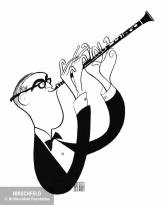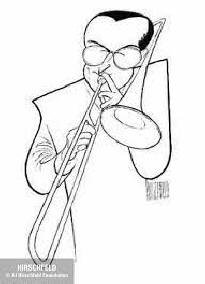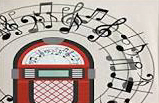

| If we do meet again why we shall
smile. If not, why then this parting was well made. Shakespeare |
D Vautier
1/2023
 The Big Band era began
around 1935 and ended suddenly and dramatically in 1947. But
as early as 1910 groups of musicians began to appear and
perform together at nightclubs and ballrooms. These consisted of perhaps a
dozen or so of local musicians who played trumpets, saxophones, trombones, base viols and drums.
They promoted a type of swing jazz dancing with arrangements of mostly
danceable music.
Most importantly, it was all swing music and each number lasted
about three minutes on average, the standard dance time.
The Big Band era began
around 1935 and ended suddenly and dramatically in 1947. But
as early as 1910 groups of musicians began to appear and
perform together at nightclubs and ballrooms. These consisted of perhaps a
dozen or so of local musicians who played trumpets, saxophones, trombones, base viols and drums.
They promoted a type of swing jazz dancing with arrangements of mostly
danceable music.
Most importantly, it was all swing music and each number lasted
about three minutes on average, the standard dance time.
The idea of a "big" band is perhaps misleading because they usually had between 12 and 16 members. That's not very big. It's just that the sound seemed big because of the predominance of brass instruments and a lot of talent.
The players were often arranged in two or three rows of four, i.e., four trumpets, four trombones, four saxophones, with drums and percussion behind them. At the front side was the band leader.
As bands became more popular they started to feature a “boy" and “girl" singer. The reason the singers were referred to this way was because they were generally much younger than the normal band members who were often in their 40s or 50s.
The vocal part of a number often begin well into the song. Arrangers preferred to emphasize melody before words. They wanted to feature the band, not necessarily the singer. Many of the numbers that the bands played did have words but the singer had to wait about a minute or so to give the band a little time to show off.
Several of these bands left a trail of good solid hits. Benny Goodman, Artie Shaw, Tommy Dorsey, Jimmy Dorsey, Shep Fields and Glenn Miller were among the top bands of the time. The "boy" and "girl" singers included such great people as Helen O’connell, Ray Eberle, Jo Stafford, Doris Day, Helen Forrest, Mildred Bailey, Frank Sinatra, Bing Crosby and Dick Jacobs, just to name a few. Many of these singers went on to their own recording careers after the big bands collapsed.
 In 1935
ballrooms bands became the absolute rave and many establishments competed to book the
more famous bands. A nightly performance could cost anywhere from $4000 to
$5000 (a lot of money in those days) for an ensemble of maybe 12 to 16 top
musicians and the famous name that went with it. Each player was paid in cash from the
night’s take and the proprietor was often able to profit from the
entertainment. There were many advantages to booking Big Bands; more customers,
more free advertising, more drinks, etc. It was very prestigious to be able to
book a Big Band.
In 1935
ballrooms bands became the absolute rave and many establishments competed to book the
more famous bands. A nightly performance could cost anywhere from $4000 to
$5000 (a lot of money in those days) for an ensemble of maybe 12 to 16 top
musicians and the famous name that went with it. Each player was paid in cash from the
night’s take and the proprietor was often able to profit from the
entertainment. There were many advantages to booking Big Bands; more customers,
more free advertising, more drinks, etc. It was very prestigious to be able to
book a Big Band.
 Big
Bands prospered greatly during the war. Dance halls were jammed full and swing music
was the rage of the time with no sign of it ever slowing down. The most noticeable
representation of swing music was Glenn Miller's Army Air Forces Band which
traveled to various camps and entertained well over a million troops before the
end of the war. In December, 1944 Miller died when his plane went down in the
Pacific but the interest in Big Band and swing music did not die at all. In
fact the Big Band movement may very well have continued much longer except for several unexpected
and unfortunate events.
Big
Bands prospered greatly during the war. Dance halls were jammed full and swing music
was the rage of the time with no sign of it ever slowing down. The most noticeable
representation of swing music was Glenn Miller's Army Air Forces Band which
traveled to various camps and entertained well over a million troops before the
end of the war. In December, 1944 Miller died when his plane went down in the
Pacific but the interest in Big Band and swing music did not die at all. In
fact the Big Band movement may very well have continued much longer except for several unexpected
and unfortunate events.
In August 1942, the American Federation of Musicians started a strike against American record companies over royalty payments. No union musician was allowed to make recordings for a record company. The union apparently felt that the recording industry was a direct competitor and serious threat to its very existence. This whole issue did not make any sense at all because recordings were part of the future of Big Band. It was essentially a self destructive, short-sighted and foolish move.
 This restriction did not cover the
"boy" and "girl" singers who performed for these Big Bands and who began recording records on their own. This in essence paved the way
for the early “ fabulous 50’s”, a period predominated by a host of strong male
and female vocalists like Perry Como, Dean Martin, Al Martino, Patti Page,
Teresa Brewer, and also the many “sister” groups like the McGuire Sisters, the Lennon
Sisters, and the DeCastro Sisters. There were also the many “Four” groups; The
Four Aces, The Four Knights, the Four Lads, the Four Freshmen, etc. These
individual singers and groups came into popularity not only as a result of the total collapse of
Big Band, but also because of their own individual talents and versatility. After
all there was a huge vacuum created by the loss of Big Bands which could well have survived another ten years and taken us directly into
the rock
and roll period without this strange musical interlude (1947-1954). Alas, it was not to be. Instead popular music suffered a kind of
hiccup starting about 1947 until 1954 which was filled by this odd assortment of
girl groups, “four” groups and strong male and female vocalists, plus all the
leftover "boy" and "girl" singers.
This restriction did not cover the
"boy" and "girl" singers who performed for these Big Bands and who began recording records on their own. This in essence paved the way
for the early “ fabulous 50’s”, a period predominated by a host of strong male
and female vocalists like Perry Como, Dean Martin, Al Martino, Patti Page,
Teresa Brewer, and also the many “sister” groups like the McGuire Sisters, the Lennon
Sisters, and the DeCastro Sisters. There were also the many “Four” groups; The
Four Aces, The Four Knights, the Four Lads, the Four Freshmen, etc. These
individual singers and groups came into popularity not only as a result of the total collapse of
Big Band, but also because of their own individual talents and versatility. After
all there was a huge vacuum created by the loss of Big Bands which could well have survived another ten years and taken us directly into
the rock
and roll period without this strange musical interlude (1947-1954). Alas, it was not to be. Instead popular music suffered a kind of
hiccup starting about 1947 until 1954 which was filled by this odd assortment of
girl groups, “four” groups and strong male and female vocalists, plus all the
leftover "boy" and "girl" singers.
However, the musician’s strike was certainly not the death knell for Big Bands or swing music. It’s only obvious result was to force the "boy" and "girl" singers to seek work in the emerging media of radio and recorded music. These singers were not bound by the strike. But the strike certainly did dampen the ability for Big Bands to popularize it’s music which it should have been doing all the time.
 However there was this idea that America wanted to forget about the war
and all its effects. This is simply not true. We surely wanted to forget
the suffering and death but not all the great Band music that had sustained us
through those terrible times. In 1946 America was in the height of optimism.
We had defeated the forces of evil both in Germany and the Pacific. Our troops
had been constantly entertained in the millions by the likes of Benny Goodman on
his hot slide trombone along with all his 45 piece musician band swinging away.
Those were the great times. Everybody loved it. The glamorous Marlene Dietrich
had appeared with Bob Hope and Big Bands were all over Europe. Big Bands and swing
dance dominated everywhere. They were hot as hell and going like hell.
However there was this idea that America wanted to forget about the war
and all its effects. This is simply not true. We surely wanted to forget
the suffering and death but not all the great Band music that had sustained us
through those terrible times. In 1946 America was in the height of optimism.
We had defeated the forces of evil both in Germany and the Pacific. Our troops
had been constantly entertained in the millions by the likes of Benny Goodman on
his hot slide trombone along with all his 45 piece musician band swinging away.
Those were the great times. Everybody loved it. The glamorous Marlene Dietrich
had appeared with Bob Hope and Big Bands were all over Europe. Big Bands and swing
dance dominated everywhere. They were hot as hell and going like hell.
 It all started with Artie
Shaw. He said that Big Band music is “listen-to” music and not “dance-to”
music. He got this idea probably from Europe where dance music is somehow
considered inferior to the more respectable and uplifting material produced by
such
longhairs as Beethoven, Brahms, and Shubert.
It all started with Artie
Shaw. He said that Big Band music is “listen-to” music and not “dance-to”
music. He got this idea probably from Europe where dance music is somehow
considered inferior to the more respectable and uplifting material produced by
such
longhairs as Beethoven, Brahms, and Shubert.
When I was a kid I built a crystal radio, as was the custom for young curious kids back then, but all I got was the local boring station KRKO out of Everett. So mom got me a regular radio that could catch all the hot stations out of Seattle; KJR, KOMO and KING. But all the kids listened to KJR because they featured DJ's 24 hours a day. That was where it was and they played pop music.
I did hear a lot of Big Band music but because of the strike, new types of music were overtaking Big Band and swing music. The new stuff was confusing to me because it was going in different directions; strong individual singers, small groups, and a potpourri of nonsensical songs from Guy Mitchell and Spike Jones. Certainly radio had allowed some of the more popular dance bands to gain national exposure, and the most popular style of dance employed strings which people actually liked a lot (https://en.wikipedia.org/wiki/Swing_music). But all of this uncertainty tended to reduce the exposure of Big Band music to the general public. Radio could have been a valuable tool to spread the "swing" but it was simply not spread.
I have a hard time believing that the radio and recording industries in any way affected the loss in popularity and sudden demise of swing music. Any suggestion of this flies in the face of fact. It was an advertising media and it could have been used extensively.
 All kinds of music
listening devices were around since the beginning of recorded music. What we recognize
today as jukeboxes became popular from the 1940s through the mid-1960s, and very
popular during the 1950s. In fact by the middle of the 1940s, three-quarters of
records produced in America went into jukeboxes. (https://en.wikipedia.org/wiki/Jukebox#cite_note-tcow-7).
All kinds of music
listening devices were around since the beginning of recorded music. What we recognize
today as jukeboxes became popular from the 1940s through the mid-1960s, and very
popular during the 1950s. In fact by the middle of the 1940s, three-quarters of
records produced in America went into jukeboxes. (https://en.wikipedia.org/wiki/Jukebox#cite_note-tcow-7).
The record companies exercised a lot of control over jukebox design and were eager to cooperate in developing standards. They built a special 45 rpm record with a large hole in the center and thin inner sides to accommodate the feed mechanisms for standard jukebox machines.
There is no indication that the jukebox offered any kind of market share threat to Big Band. Jukeboxes operated in cafés, dinner houses, lunch rooms, restaurants, bars and taverns. In fact the kind of music preferred in the 1940s was Big Band. There were never any jukeboxes in the dance halls and ballrooms where the Big Bands performed.

After the war In 1946, inflation rose to a staggering 18 percent. In 1947 it was more than 20 percent, the highest in modern history. This was mostly the result of the lifting of wartime wage and price controls in addition to shortages everywhere; cars, houses, you name it. Certainly this had a profound effect on entertainment costs, especially Big Band bookings.
In 1944 the U. S. Government decided
that the tremendous war debt had to be extinguished by extraordinary means.
They recklessly decided to discourage many organized forms of entertainment by
passing the so-called “Cabaret” tax which was in effect from 1944 until
1965 at an initial ruinous rate of 30%. This disastrous tax actually seems to
have changed the direction of swing jazz dancing and basically taxed Swing
Music out of existence.
As the Big Bands began to struggle, bookings disappeared. Ballrooms, dance halls and casinos could no longer afford Big Bands but instead resorted to smaller performers, comedians, and local entertainers. So, one by one the Big Bands folded. First was the famous Harry James who owned one of the most popular bands in America. James even cut his prices in half from $4000 to $2000 a night (Goulden,The Best Years, 1976, p.166). He could still not get bookings so by the end of 1946 he “disbanded” his band. Later James restarted his band but it was never the same.
Other bands soon followed suit as bookings dried up and travel and lodging expenses increased. The year 1947 saw the complete massacre of the Big Bands and with it the swing dancing industry; Woody Herman, Tommy Dorsey, Jimmy Dorsey, Les Brown, Jack Teagarden. They all simply quit. Nobody could afford them anymore.
As it later turned out, the whole “Cabaret” tax was actually unnecessary. The World War Two debt was paid off in just 20 years. This was in addition to the huge assistance we were giving to the war torn countries through the Marshal Plan. And all this assistance was accomplished by many other extremely aggressive tax rates on income, corporate profits, etc., so the debt shrank fast and significantly. Despite the heavy tax the US economy continued to grew well. It would take the debt-to-GDP ratio only until 1962 to get back to where the US was before the war.
But one terrible casualty of all this was swing music and the Big Bands.